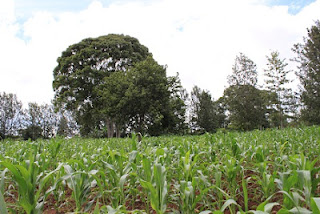Note: these photos were taken from moving vehicles through windshields. Quality has suffered as a result.
Travelling
around the diocese of Buyé involves using a combination of the main
national highway and secondary, unpaved roads.
 |
| National Highway |
 |
| Secondary Road |
The highway is always
busy, but not in the sense that highways in Canada can be busy. Along
the highway we encounter a few cars, buses, taxis and trucks. It is
possible to go quite some distance without seeing another car. But it
is impossible to go very far without seeing anyone. Motorcycles and
bicycles outnumber four-wheeled vehicles, and by far the most
frequent traffic along the highway is foot traffic. It seems
impossible to go more than 100 metres without seeing someone walking
along the highway.
 |
| Women passing banana stalk placed there for a dignitary |
We
see people carrying enormous loads of goods to markets on bicycles,
either laboriously pushing them up hill or riding down the other side
at breakneck speed. In this way people take their loads of bananas or
charcoal or wood to be sold. (Burundi is very mountainous, so it
seems that we are always either going up hill or down.)
 |
| Taking bananas to market |
Others
use bicycles as basic transport, often carrying someone else on the
back.
 |
| Taking charcoal to market |
We
also see people (mainly colourfully dressed women) carrying baskets
or farm implements on their heads, often with a baby strapped to
their back.
People
carry anything and everything on their heads. It's actually quite an
efficient way to carry a load. Children carry their schoolbooks on
their heads, and both men and women carry enormous loads of goods on
their heads. We're told it's possible to carry up to 60 kg on one's
head. All it takes is practice, balance, and a cushion that is
traditionally made from a banana leaf.
And
we see crowds of children, young and old, on their way to and from
school. Usually when they are on the way home they seem more playful,
running and fooling around like school children anywhere.
Along
the side of the highway in the villages and towns there are the usual
homes and shops and various institutional buildings such as
government offices, hospitals, churches, schools and so on. In
between towns, we encounter people cultivating fields, herding goats
or cows, producing bricks or charcoal or selling things at roadside
stands.
 |
| A heavy load of charcoal |
Sometimes
we see small leafy branches on the road, which is a sign that there
is an accident scene or a broken-down vehicle ahead, much as we might
use flares in Canada.
Often
we see people on bicycles holding on to the back of a truck to catch
a lift up hill, five, six, seven at a time across the back of the
truck; or people who have climbed up and are holding on for dear life
on the back of a shipping container.
 |
| Don't try this at home |
The
secondary roads vary in quality from relatively smooth to very rough.
Progress can be slow as we must often negotiate the ruts and potholes
and the miniature river valleys carved down the road by runoff. On
secondary roads we give up driving on the right. Instead we drive
wherever the road is smoothest, weaving back and forth in a slalom
course along the road. Because these roads can be so rough an SUV is
essential. A more delicate car wouldn't survive very long in these
conditions.
 |
| Bridge on a secondary road |
Secondary
roads can be a bit less populated than the main highway, but they are
still dotted with villages at frequent intervals and there is always
someone coming or going from village to village. The main difference
in traffic is that there seem to be fewer four-wheeled vehicles on
the secondary roads, and more people on foot spread out across the
road as they come and go. A horn is an essential bit of equipment as
we constantly need to warn people of our approach.
 |
| Entering a village |
All
along the route, there is always something to see, always people
coming or going, curious people wondering who we are, often waving or
shouting greetings. And the scenery is spectacular. Burundi is a very
beautiful country.



































































